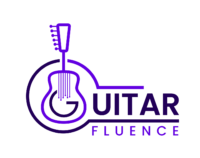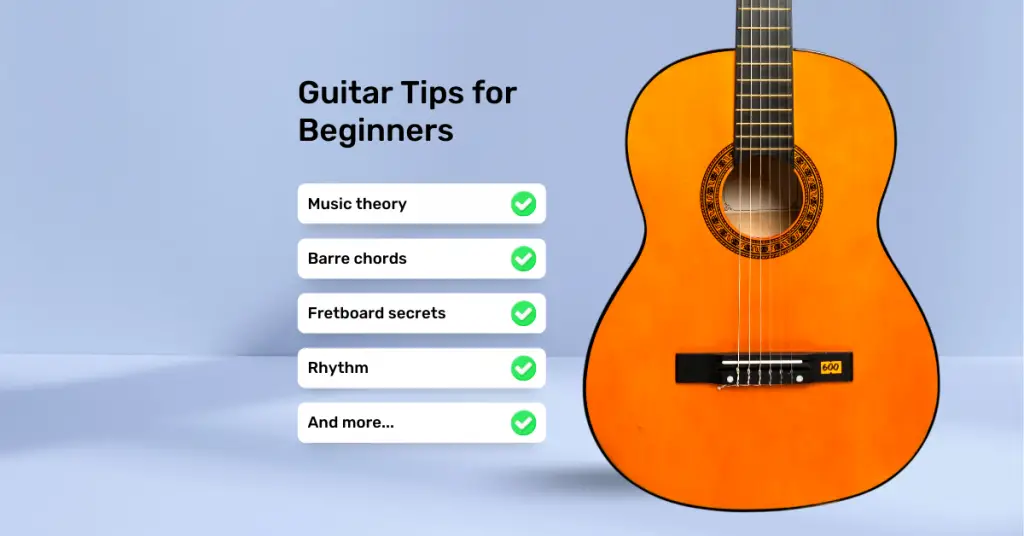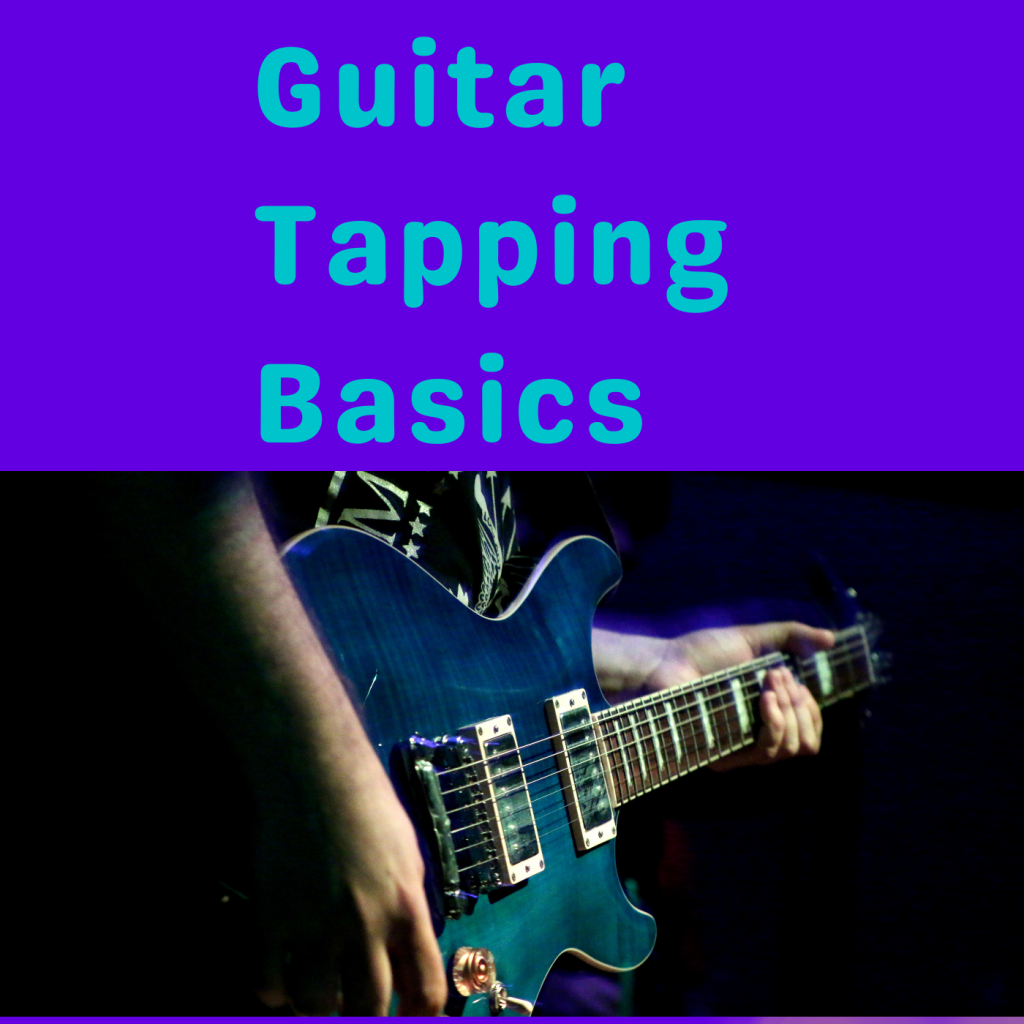Table of Contents
When I was a beginner I was fortunate enough to have a guitar instructor.
Even so, there was still a lot that I didn’t learn until years into my guitar playing journey. I stumbled a lot along the way, and I am grateful to be where I am now in my playing.
Because I want you to not stumble the same way that I did, I’m going to give you some guitar tips for beginners. These are guitar tips that I wish I’d known when I first started out.
Let’s go.
Practice often
When you’re first starting guitar it may seem like a good idea to practice for long hours. While this doesn’t hurt, it’s far more valuable to practice often rather than for long periods.
You’ll have to start reteaching yourself over and over if you do not practice often, and that’s just a huge waste of time.
And remember, practice is different than noodling. You will be exercising something new and somewhat foreign if you are practicing. You are noodling if you are just playing for fun.
Noodling is not a bad thing, though! That’s what will keep you playing your guitar forever! Just remember to have good quality practice sessions, and noodle at other time.
Holding your guitar pick
When starting you’ll probably hold your guitar pick like this:
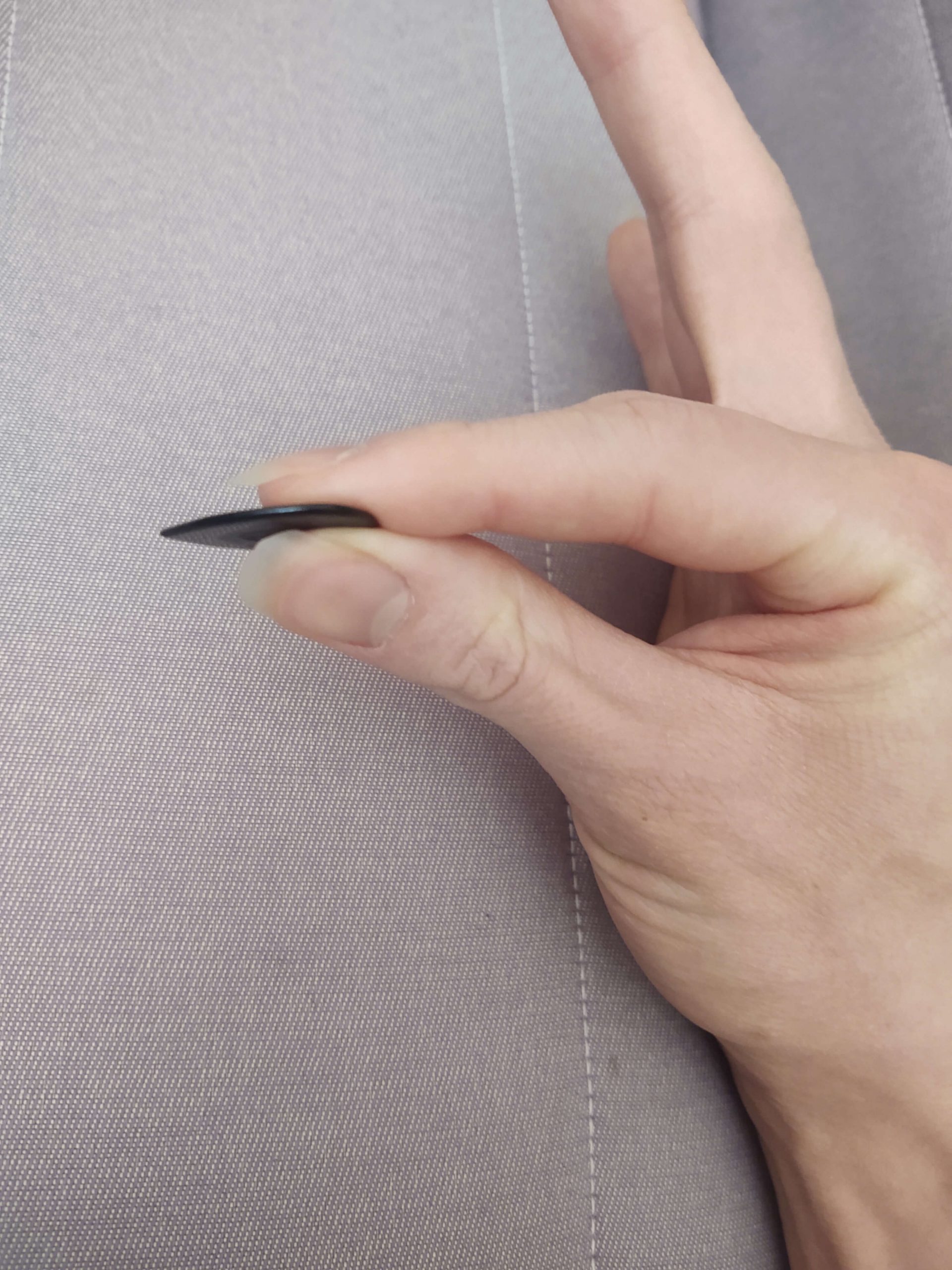
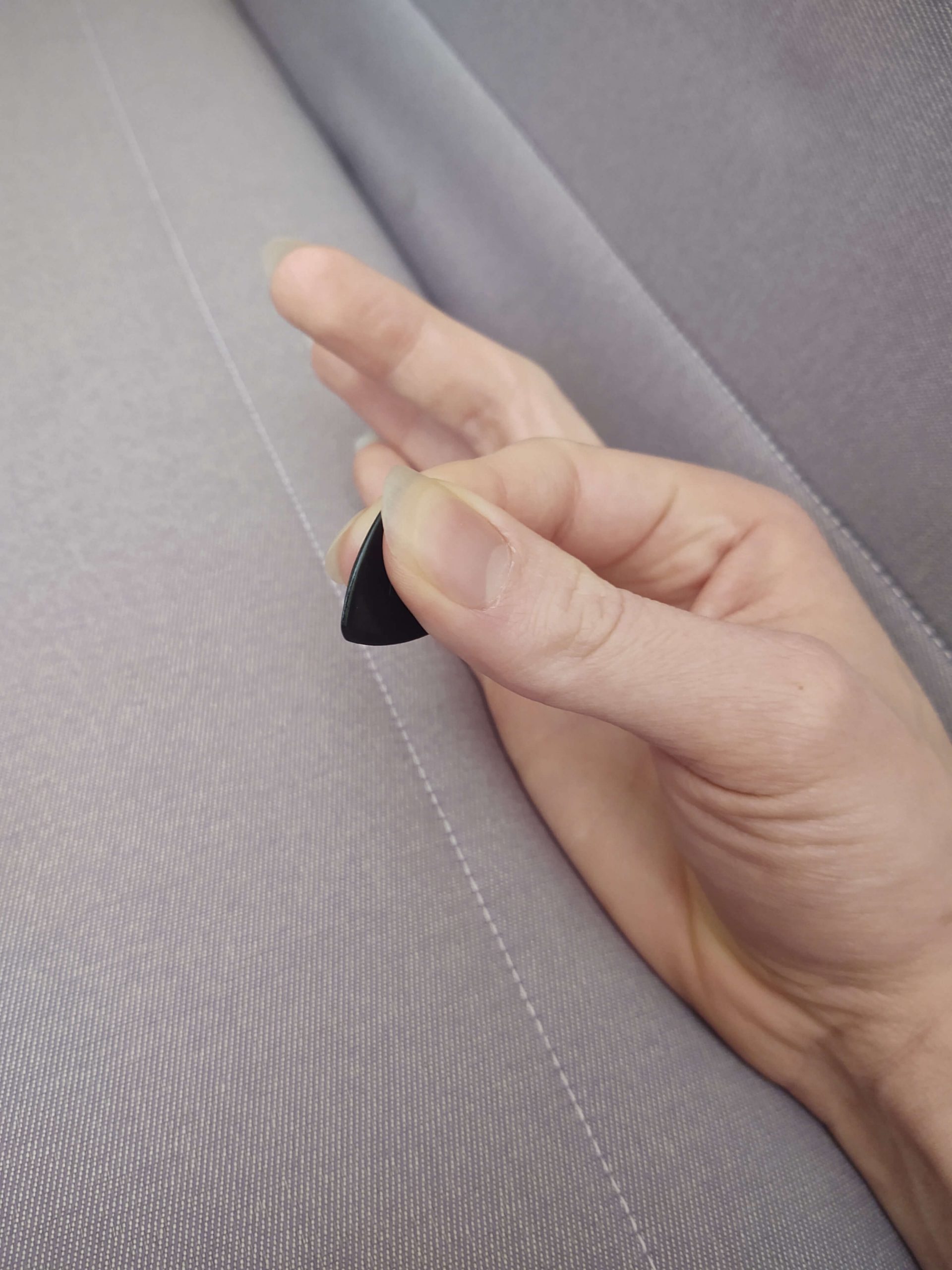
However, the best way to hold the guitar pick, in my experience, is with the “D” shape. Here’s what that looks like:
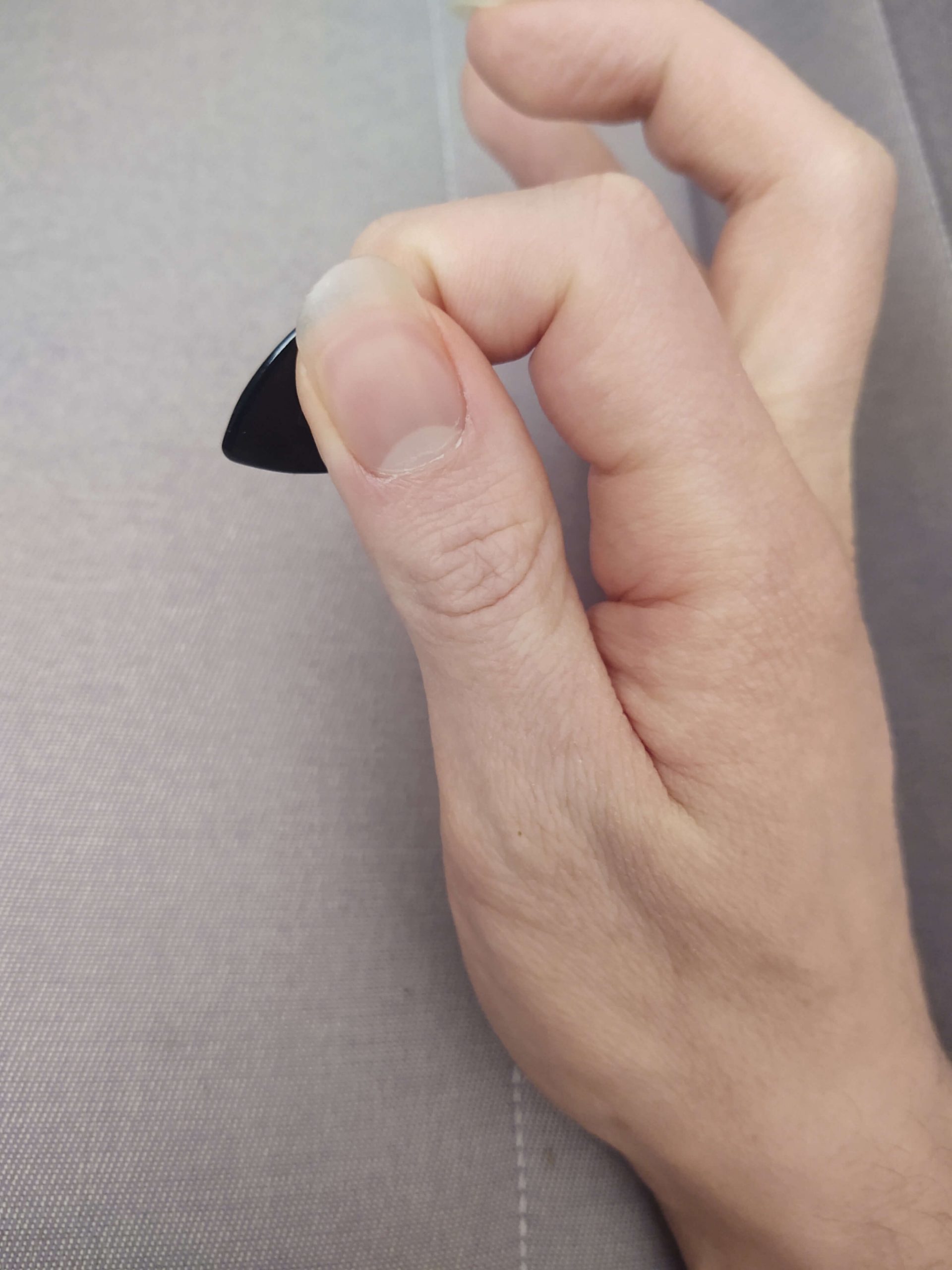
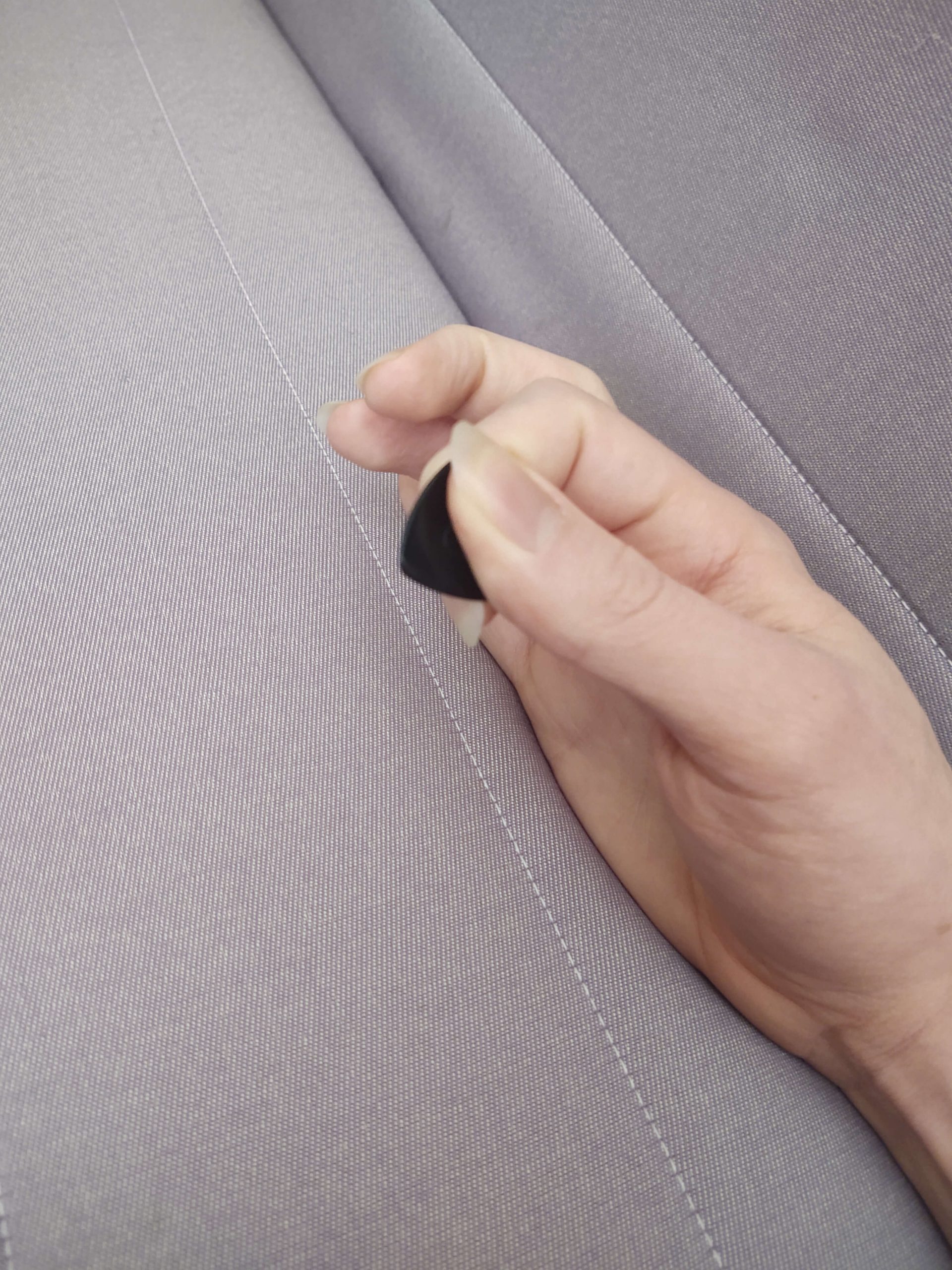
Does everyone hold their pick like this? No, but it always helps to get an idea of what is relatively standard.
There are many guitar players who seem to have an unnatural approach to holding their guitar picks, but I assure you they have developed their picking hand for years. And don’t forget, the way that your favorite player is holding his or her pick may not be the best for you to hold yours.
Posture
Posture is so important. And the problem is, many guitar teachers don’t know how to properly teach you correct posture.
Some guitar books do cover it briefly, but usually not enough to make a big difference.
I’d suggest consulting your primary physician or your physical therapist if you are having a hard time sitting correctly.
Barre Chords
Barre chords can really suck when you’re starting guitar. Heck, they even suck when you’re experienced! Luckily there are a few simple tips for making them easier.
Mini Bars
Practice your barre chords using smaller bars, rather than playing an entire barre chord at once. If you can’t get the bar down by itself, then don’t expect to grasp the full chord yet.
Use the side of your finger
Approach your bars with the boney side of your finger, and not the pads on the front side.
Don’t Barre the entire fret
You only need to emphasize the barre on the strings where it really matters. On an F Chord, for example, you only need to put strength on the 1st frets of the Low E, B, and High E strings.
Be Patient
Practice makes perfect, and you practice requires patience. You’ll master your barre chords in no time if you just keep working on them!
If you have exhausted all your other options for learning barre chords, try consulting a guitar instructor for help.
Guitar Maintenance
Maintaining a guitar may seem simple, but you don’t want to neglect it, and you certainly don’t want to do it wrong.
Teach yourself how to restring your guitar. Try different gauges of strings, and figure out which strings work the best for you.
Once you have figured out your favorite string gauge, I suggest getting your guitar setup by a guitar tech. You can learn how to maintain your guitar on your on too, but there’s a good chance that you’ll just mess it up.
Make sure you’re using a reputable resource if you do teach yourself to maintain your own guitar. A poor resource can lead to a guitar project that ends up in a box, and is put off for months to come.
Here’s a great guide on maintaining and caring for your guitar: https://www.sweetwater.com/sweetcare/articles/guitar-care-and-maintenance-guide/
Relax your left hand
You’ll find that your left hand will flow effortlessly the more you relax it. Your wrist and thumb will start to find relief as well, and this will allow you to play guitar for far longer periods of time.
Along with relaxing your left hand, practice keeping your fingers as close to the fretboard as possible. This will help you with transitions, left and right hand synchronization, and with hammer-ons.
Always be in tune
It’s so frustrating to see beginner guitarists who don’t play in tune. Or even worse, experienced players who aren’t in tune.
Playing in tune will help you develop your ear, and assist you in learning songs.
Aside from that, you’ll sound good! If you’re out of tune, you’ll sound bad, and you won’t be able to recognize the sounds of chords as you progress.
Musical Alphabet
The musical alphabet needs to be a top priority when learning any instrument! This especially holds true for the guitar.
Once you understand the musical alphabet it will help you with fretboard visualization, and with musical communication as well.
Alongside this it doesn’t hurt to learn how to read music. Learning to read music will help you grasp where the notes are, plus it’s a relatively necessary skill if you plan on playing in a professional band, or plan on playing in a session setting.
Music theory
Music theory refers to a lot of things…
It can be dynamics, harmony, rhythm, reading notes, and obviously much more.
I suggest starting with the basic fundamentals of reading rhythms, and understanding basic harmony. Then move on to learning the C Major scale.
Music theory will be necessary to learn if you are looking to communicate with other musicians! This is what makes music theory so spectacular. Music is a language, and music theory is the study of the language of music.
Rhythm guitar/Timing
Rhythm is the most valuable skill to master. You can have the best understanding of harmony and melody on the planet, but it will do nothing for you if your rhythm sucks!
So please, practice rhythm.
Here are some tips for practicing:
- Tap your foot to the beat
- Practice at a slow, steady tempo
- Count out loud
- Don’t rush your music
As you start to apply these simple tips you will develop a strong sense of rhythm.
String Names
String names are pretty easy to learn, and it’s the first step in memorizing the notes on the fretboard.
Come up with a phrase that helps you to remember the names. Here’s a popular phrase: (Start from the bottom)
Eddie
Bye
Good
Dynamite
Ate
Eddie
Seriously, this is so easy to do and so necessary! So don’t put it off.
This bring us to memorizing your notes!
Memorize your notes
So, you’ve got your open strings down. Now you’ll want to memorize your notes on the fretboard.
This will help you with understanding chord names, intervals, and communicating with other musicians!
Don’t get overwhelmed. Start with your Low E String, and then learn your A string. Only learn the natural notes, because you’ll already know where the sharps/flats are if you have the natural notes down!
Getting down the E and A Strings means that you already have half of the fretboard down! This is because there are two E strings.
From there you just have the other half of the fretboard. Use the E and A strings to identify octaves, which will help you memorize these notes faster.
Dots on the neck
As a beginner, I had no idea what the dots on the neck were.
I had a much easier time navigating the fretboard when I learned their purpose.
The dots on the neck represent usually represent specific fret numbers. So if you have a dot on frets 3, 5, 7, 10, and 12 it will make it far easier for you to find fret numbers on command, which is great because it’s easy to get lost on the guitar.
Any feature that helps you navigate your fretboard is always a good thing!
Moveable Chords
Chord shapes are movable! When you move a chord, the name of the chord changes based off of the root note. This means that changing keys on the guitar can be effortless!
Even if you are moving an open string chord shape, you just have to take the open string and move it up one fret.
Plain and simple!
Scales are simple
Every scale has a simple formula of whole steps and half steps that you follow.
The major scale looks like this:
W-W-H-W-W-W-H
(W=Whole Step) (H=Half Step)
Those are the steps in which you would move away from your root note.
Start by practicing scales across a single string. This will help you to understand the sound and interval structure of the scale.
Once you have heard the scale it will be much easier to practice across multiple strings, because you’ll recognize the sound of the scale, and you will be able to hear your mistakes.
The structure of the whole and half steps will also be recognizable, which will also help you!
Listen to Guitar Players
Listening to renowned guitarists will help you in so many ways.
It will guide your sound. A guitar can make so many different sounds, and you’ll benefit greatly from knowing what a good sound is to both yourself and other guitar players.
You’ll also better gain a better understanding of the guitar when you listen to the greats.
And let me ask, how would you learn your instrument if you don’t even know what it sounds like? You could learn the fundamentals of guitar, no doubt. You’d be leaving a lot of ideas on the table if you don’t listen to other guitar players, however.
Network and make friends
Networking will lead to so many different opportunities. This can lead to finding good bandmates, good deals on instruments, getting your dream gig, and most importantly: learning!
Learning from a friend is one of the best ways to learn guitar. You never know what type of perspective they will bring to the table.
And the best part? It’s free!
As long as you are providing value and honest feedback, they will provide that same value in return.
Seriously, networking can lead to guitar opportunities that never would’ve happened if you’d stayed in the guitar-playing closet forever. Get out there and find a friend in your music scene, and start giving value to your local music community. It’ll be the best thing for your guitar playing.
Don’t buy a cheap guitar
One of my first guitar students was an 8-year old girl. She had a dirt cheap guitar. I tried to teach her the basics of guitar, but she simply could not play. She could barely fret a single note.
I tried the guitar myself, and even I could barely play it! I told her mom about this.
The mom said she did not want her daughter to get a better guitar until she has some experience… Good luck getting experience with a crappy guitar.
Anyways…
Please don’t buy a cheap instrument. And when I say cheap, I do not mean inexpensive. That term is relatively subjective.
When I say cheap, I mean a guitar that is poorly built. Some guitars are simply unplayable, and how are you supposed to practice when your guitar is unplayable?
The answer is simple: You can’t.
Embrace your limitations
This cannot be stressed enough. Embracing your limitations will ultimately lead to you finding your voice on the instrument.
This essentially means focusing on what you’re good at, rather than wasting time on something that may not benefit you.
For example, there’s no reason for Matteo Mancuso to use a guitar pick because his right-hand technique is already flawless without it.
There’s no reason for Slash to learn sweep picking, because that’s just not his style.
BB King never learned to shred, because that just wasn’t his sound!
Do you get the point? Embrace your limitations! It’s one of the best guitar tips for any guitarist. Don’t get held up on techniques that won’t contribute to your voice on the guitar.
Guitar Tips For Beginners Conclusion
There you have it. 19 Guitar tips for beginners.
Start small, and don’t let the list overwhelm you!
Start networking in your community.
Practice keeping your foot on the beat.
Embrace your limitations!
Seriously, just take baby steps. Let me know in the comments what you’ll start with!
And last but not least, remember to enjoy the process. Your guitar journey will never end, so it’s best to enjoy it the entire way.
